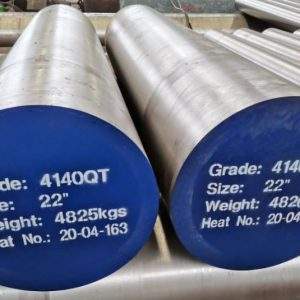Introduction
In the world of metallurgy and industrial manufacturing, the hardness of steel plays a crucial role in determining its applicability and performance in various applications. Among the multitude of steel grades available, 4140 steel stands out due to its exceptional hardness and versatility. This blog will delve into a comprehensive comparison of 4140 steel hardness with other steel grades, providing insights that will help engineers, metallurgists, and manufacturers make informed decisions about material selection.
What is 4140 Steel?

4140 steel, also known as chromoly steel, is a low-alloy steel that contains chromium and molybdenum as its primary alloying elements. This combination gives 4140 steel its distinctive hardness, toughness, and wear resistance. The specific composition of 4140 steel includes approximately 0.38-0.43% carbon, 0.75-1.00% manganese, 0.80-1.10% chromium, and 0.15-0.25% molybdenum.
Key Properties of 4140 Steel
- High tensile strength
- Excellent wear resistance
- Good ductility and toughness
- High fatigue strength
- Strong machinability and weldability
Measuring Steel Hardness
Before we dive into the comparison, it’s essential to understand how steel hardness is measured. The most common methods include the Rockwell Hardness Test, Brinell Hardness Test, and Vickers Hardness Test. These tests involve indenting the steel with a specific force and measuring the size or depth of the indentation. The resulting hardness value provides a measure of the material’s resistance to deformation.
Rockwell Hardness Test
- Uses a diamond cone or steel ball indenter
- Measures depth of indentation
- Common scale for steel: Rockwell C (HRC)
Brinell Hardness Test
- Uses a hardened steel or carbide ball
- Measures diameter of indentation
- Results given in Brinell Hardness Number (BHN)
Vickers Hardness Test
- Uses a diamond pyramid indenter
- Measures diagonal length of indentation
- Results given in Vickers Hardness Number (VHN or HV)
4140 Steel Hardness Compared to Other Steel Grades
To provide a detailed comparison, we’ll look at several steel grades commonly used in industrial applications: 1018, 1045, 4340, and D2. Each of these steels has unique properties and applications, influenced significantly by their hardness.
4140 Steel vs. 1018 Steel
1018 steel is a low-carbon steel with a relatively low hardness compared to 4140 steel.
| Property | 4140 Steel | 1018 Steel |
|---|---|---|
| Carbon Content | 0.38-0.43% | 0.15-0.20% |
| Hardness (HRC) | 24-32 | 12-20 |
| Tensile Strength | 655 MPa | 440 MPa |
| Applications | Gears, shafts, axles | Structural components, gears |
4140 Steel vs. 1045 Steel
1045 steel is a medium-carbon steel known for its good strength and hardness but lacks the alloying elements found in 4140.
| Property | 4140 Steel | 1045 Steel |
|---|---|---|
| Carbon Content | 0.38-0.43% | 0.42-0.50% |
| Hardness (HRC) | 24-32 | 18-22 |
| Tensile Strength | 655 MPa | 585 MPa |
| Applications | Gears, shafts, axles | Bolts, connecting rods |
4140 Steel vs. 4340 Steel
4340 steel is an alloy steel that includes nickel, which enhances its hardness and toughness compared to 4140.
| Property | 4140 Steel | 4340 Steel |
|---|---|---|
| Carbon Content | 0.38-0.43% | 0.38-0.43% |
| Hardness (HRC) | 24-32 | 30-38 |
| Tensile Strength | 655 MPa | 745 MPa |
| Applications | Gears, shafts, axles | Aircraft landing gear, power transmission gears |
4140 Steel vs. D2 Steel
D2 steel is a high-carbon, high-chromium tool steel known for its exceptional hardness and wear resistance, surpassing that of 4140.
| Property | 4140 Steel | D2 Steel |
|---|---|---|
| Carbon Content | 0.38-0.43% | 1.40-1.60% |
| Hardness (HRC) | 24-32 | 55-62 |
| Tensile Strength | 655 MPa | 1,785 MPa |
| Applications | Gears, shafts, axles | Dies, cutting tools, punches |
Practical Applications and Implications

Engineering Considerations
When selecting a steel grade for a specific application, engineers must consider not only the hardness but also other properties such as tensile strength, toughness, and machinability. For example, while D2 steel offers superior hardness and wear resistance, it is also more difficult to machine and can be more brittle compared to 4140 steel.
Cost and Availability
The cost and availability of steel grades can also impact the decision-making process. 4140 steel, being a widely used alloy steel, is readily available and often more cost-effective than specialty steels like D2.
Conclusion
Understanding the hardness of 4140 steel in comparison to other steel grades is crucial for making informed decisions in engineering and manufacturing. With its balanced combination of hardness, strength, and toughness, 4140 steel proves to be a versatile and reliable choice for many applications. However, depending on the specific requirements, other steel grades like 4340 or D2 might be more suitable, offering higher hardness and wear resistance.
FAQ
What is the typical hardness of 4140 steel?
4140 steel typically has a hardness of 24-32 HRC.
How does the hardness of 4140 steel compare to 1018 steel?
4140 steel is significantly harder than 1018 steel, with 4140 having a hardness of 24-32 HRC compared to 1018’s 12-20 HRC.
Is 4140 steel suitable for making cutting tools?
While 4140 steel is tough and hard, it is not as suitable for cutting tools as high-carbon, high-chromium steels like D2, which offer higher hardness and wear resistance.
Can 4140 steel be heat-treated to increase its hardness?
Yes, 4140 steel can be heat-treated to increase its hardness, making it even more versatile for different applications.
What industries commonly use 4140 steel?
4140 steel is commonly used in industries such as automotive, aerospace, oil and gas, and manufacturing for making components like gears, shafts, and axles.
